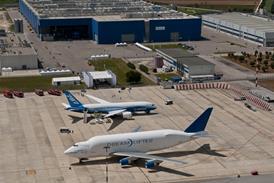Near the village of Villacarrillo in Andalusia’s Jaén province, in the foothills of the Sierra Nevada mountains and two hours’ drive from Granada, there is, carved out of the region’s endless olive groves, a miniature airfield.
A visitor could be excused for thinking this small runway, control tower and hangar were an aero-enthusiast farmer’s folly – except ATLAS, the Air Traffic Laboratory for Advanced unmanned Systems, is in fact the latest move in a very serious drive to make this Spanish region’s mark on aerospace technology. Opened on 21 March by the president of Andalusia, Susana Díaz, ATLAS is a permanent test facility available to unmanned air system (UAS) developers. One early customer for its 1,000km2 (390 miles2) of unrestricted airspace with a 5,000ft (1,520m) ceiling will be Boeing Research & Technology Europe.
But many ATLAS users will be players in Spain’s growing indigenous aerospace sector; Madrid-based Unmanned Solutions (USOL) had two aircraft lined up at ATLAS for its grand opening – and both the K50 and K150 models attracted a great deal of interest from a Spanish air force general and his adjutant who were on hand.
Critically, ATLAS is closely allied to the Seville-based aerospace technology development laboratories centre CATEC, which has been established for three years now at the Aerópolis aerospace industrial park adjacent to Airbus Defence & Space’s A400M final assembly line. UAS are a key focus at CATEC, which had its latest, 5kg (11lb) model, “Locomove”, hangared and ready for flight from ATLAS’s pristine tarmac. Silvia de los Santos, a CATEC affiliated aeroengineer who has spend the past four years working to help organise the budget to build ATLAS, described herself as being “in tears” when arriving in Villacarrillo for the opening.
That de los Santos and her colleagues could muster €4 million ($5.5 million) for ATLAS – including €3.5 million of partly EU funds channelled through the Andalusian government and another €500,000 from Madrid – says much about how seriously this project is taken.
As Díaz observes, aerospace accounts for a turnover of €1.8 billion in Andalusia and 11,300 direct jobs, making up 1.28% of the regional economy and 17% of its industrial GDP.
More money is on the way, imminently, according to ATLAS director Anastasio Sánchez Bernal, to extend the 600m runway to 800m, which will allow the operation of any UAS up to about 12m wingspan and 600-700kg MTOW. That, he stresses, takes in any civil UAS operating in Europe today and all but the biggest military systems.
Andalusia will soon be able to host much larger systems too. Construction will begin in mid-2014 on another facility at the National Institute of Aerospace Technology (INTA) in Huelva province. Backed by the national government and the defence ministry, the CEUS (Centre for Unmanned Systems) has an astonishing €40 million budget and is expected to generate 250 direct and 500 indirect jobs.
Andalusia is not alone in courting the UAS industry. Late in 2013, West Wales airport at Aberporth and Newquay Cornwall airport joined forces to initiate what they claim is the world’s first civilian centre for UAS operations.
Indeed, with the backing of airspace manager NATS, its own Aerohub Enterprise Zone, the UK’s massive aerospace industry and a formidable expanse of available local airspace, the UK National Aeronautical Centre won’t easily be brushed aside by Andalusia’s bid to dominate unmanned flight. There is, however, one advantage that Andalusia will always have over Wales – or just about anywhere else in Europe. As Sánchez Bernal points out, Villacarrillo boasts 300 sunny days a year.
Source: Flight International























